Canoeing the Peace River in Northern Alberta
Unless you’re from northern Alberta, the Peace River probably doesn’t register on your radar. Yet it’s a huge river that dramatically cuts across the province for over 1,000 kilometres. Starting in the Rocky Mountains of northern British Columbia, the Peace River flows northeast through Alberta to empty into the Slave River, one of the Mackenzie River tributaries. The Mackenzie is the tenth longest river in the world! Canoeing the Peace River is a fabulous Alberta adventure but from what I saw hardly a soul knows about it.
Or as Andrea Lindsey says who has canoed it, people are afraid of the river but shouldn’t be.
This post includes some affiliate links. If you make a qualifying purchase through one of these links, I will receive a small percentage of the sale at no extra cost to you. Thank you very much for your support.
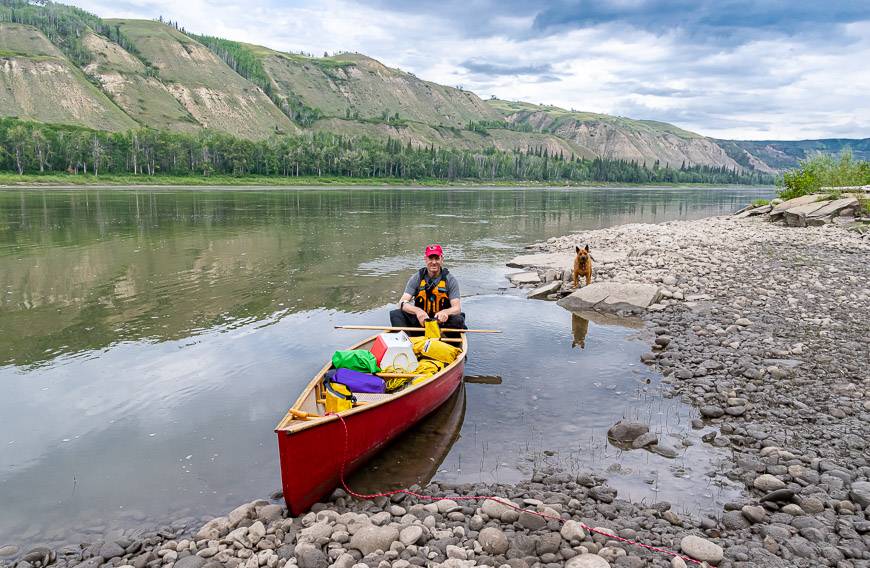
Would you like to save this?
Canoeing the Peace River – Class I with no portages or rapids
The Peace River is a Class I river which means there are no rapids and as a bonus there are no portages either, at least on the section we paddled.
The flow rates can vary dramatically according to what is discharged from the W.C. Bennett Dam so you must camp high and pull your canoe up every night. The only other hazards are occasional errant boulders and shallow gravel bars. You learn to take the outside curve of the river to avoid grounding out.
Day 1 – Cotillion Recreation Area to Many Islands Park
Distance: 40 km
Time: 5 hours with stops
We rented canoes and got a shuttle from Peace River Cabins and Outdoors. The night before was spent in one of their charming self-catering cabins overlooking the Peace River.
Although we could have chosen any number of launch sites we had decided to start at the Cotillion Recreation Area as a four day paddle would get us into the rhythm of life on the river. This launch site, a 2.5 hour drive from the Peace River Cabins, is only about 30 kilometres shy of the British Columbia border.
According to Theresa Griffith, the author of the free Peace River Paddling Guide, once on the Alberta section of the Peace River you’re on a prairie river rather than a mountain river with the hills less cliff-like and sandier in nature. I think they’re still very impressive and far more dramatic than what I expected.
We saw only one power boat over the 40 kilometres paddled – and not another canoe. Although we spied only a few mule deer on the first day, it’s apparent that a lot goes on along the river judging by the quantity and diversity of animal tracks.
There aren’t a lot of choices when it comes to camping along the Peace River. As much as I like wild camping without a soul around, it wasn’t to be on this river – and it certainly wasn’t worth the effort. The banks are slippery, muddy and high so lugging gear and then finding a flat spot without a tree or a bush is a challenge.
Over the four day trip we made campgrounds are daily destination.
The Many Islands Campground requires quite a slog to reach the actual campsites. Our site was about 400 metres from the water so not only did we get lots of exercise paddling but it took three loads to get everything up.
We picked the closest campsite and didn’t have any neighbours. In exploring the campground I spoke with one woman who said she paddled the Peace about 20 years ago. Her first comment – isn’t it beautiful? It really is – and that’s why John and I were both baffled that we hadn’t seen another paddler all day.
The campsites are $15 per night and offer outhouses, picnic tables and potable water. There is a camp host onsite as well.
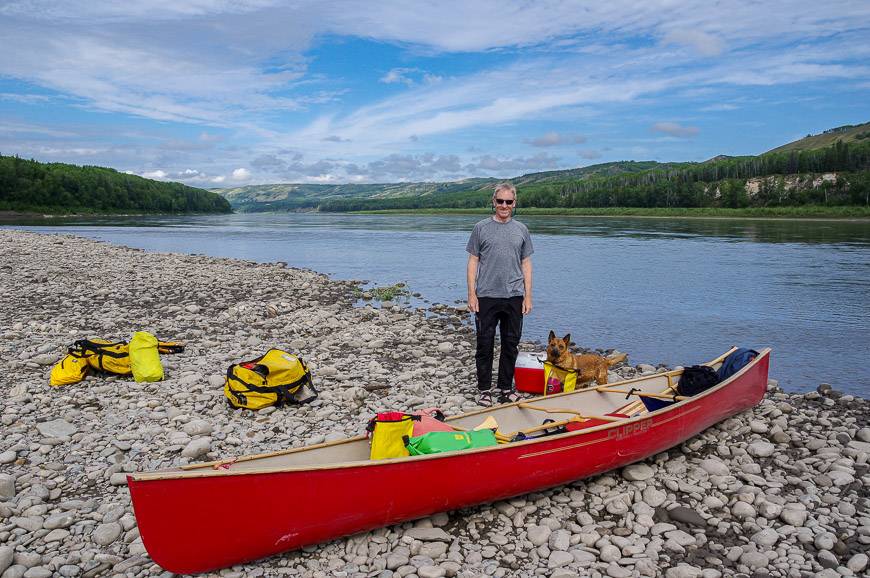
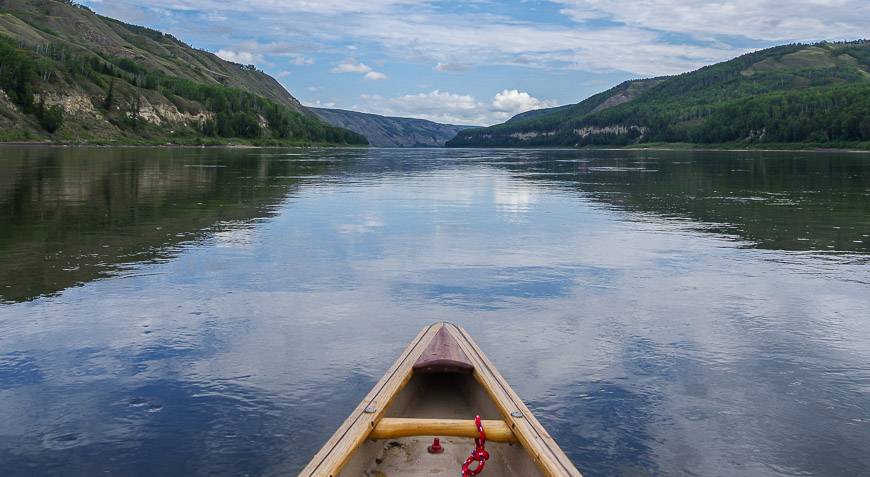
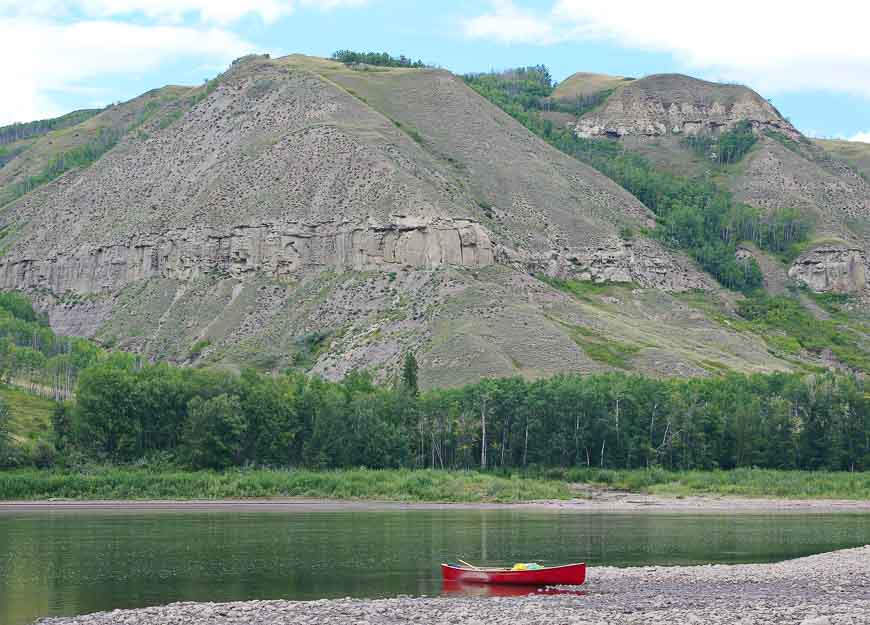
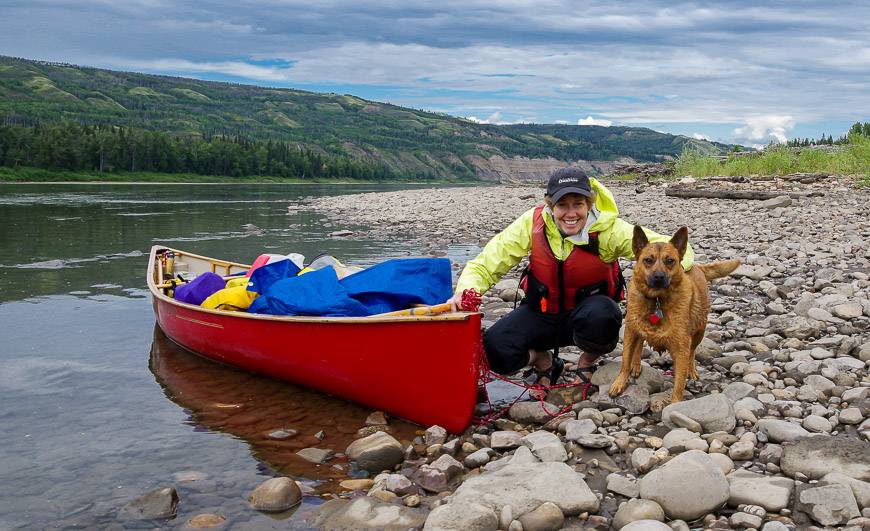
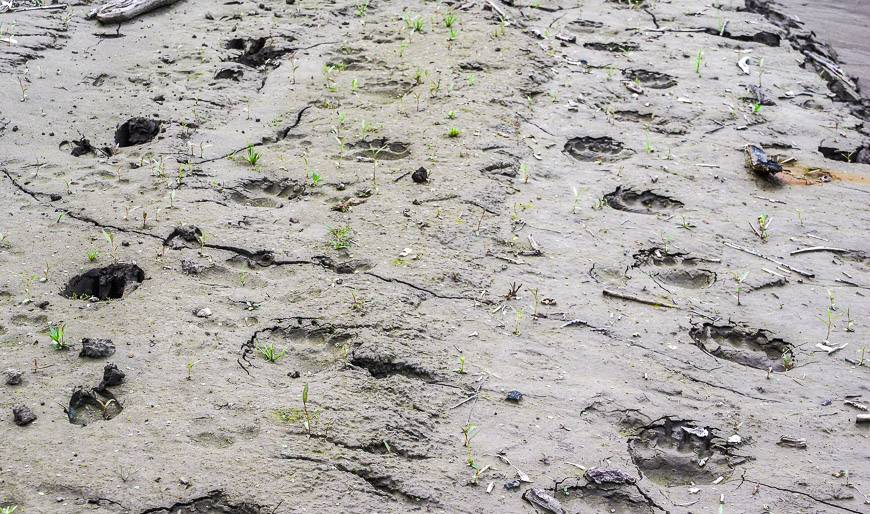
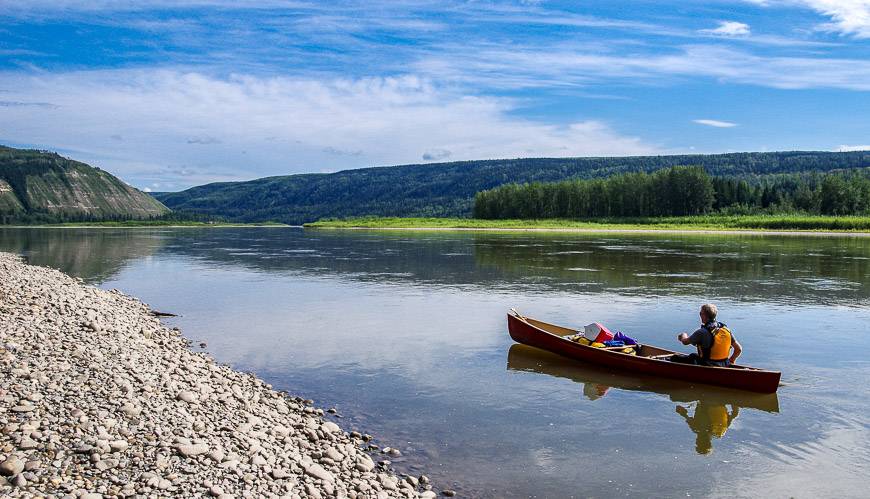
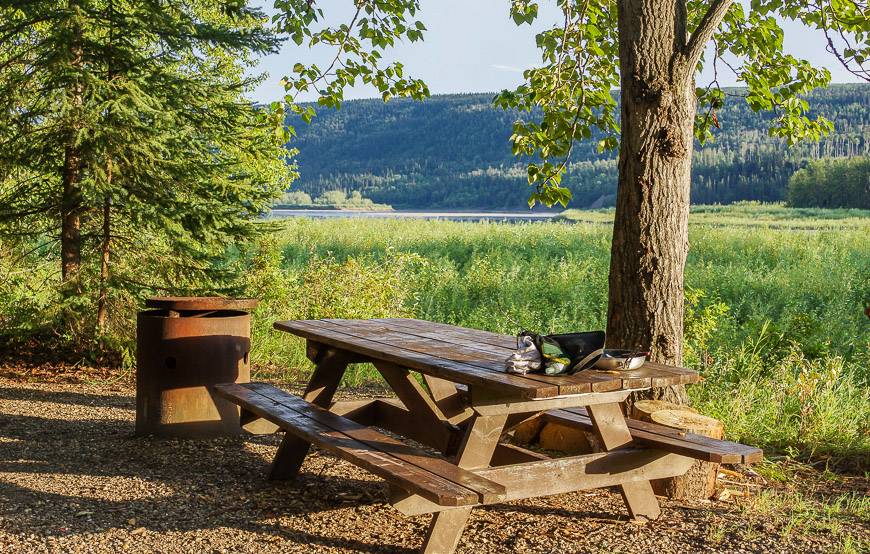
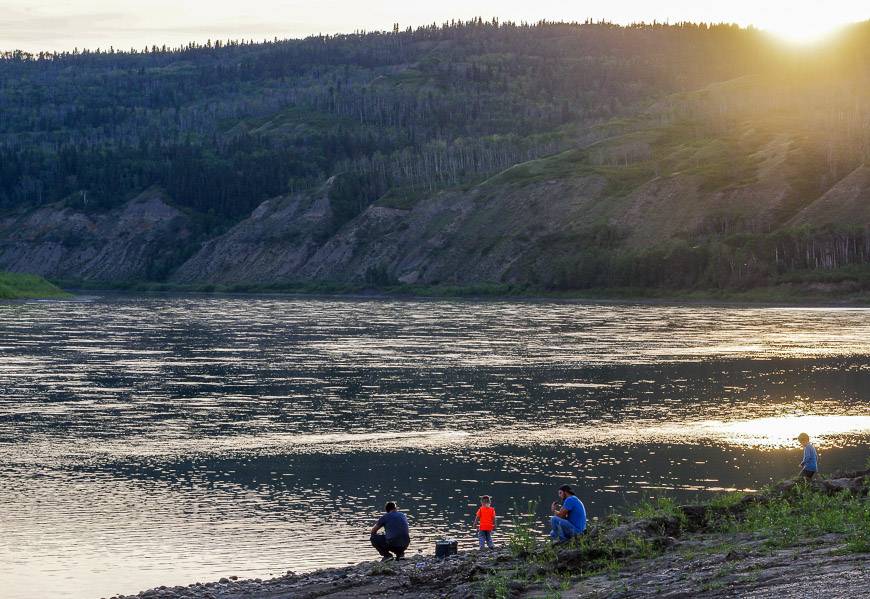
Day 2 canoeing the Peace River: Many Islands Park to Pratt’s Landing
Distance: 41 km
Time: 5 hours with breaks
On the second day we set out at a leisurely hour as we figured we could knock off 41 kilometres in short order. The current makes the 40 + kilometres in a day possible.
We’d been told the river was flowing at about 8 km/hour and in places it was certainly moving but there were lots of times over the four days we went looking for stronger current.
This was another delightful canoeing the Peace River, even with a 90-minute rain shower. We saw more wildlife – perhaps five deer, four beavers (one that splashed directly in front of me) and a coyote but not a soul all day.
The scenery was similar to the first day with big hills lining the sides of the river but there were more islands. We missed a stop at Carter Camp – which can be reached by road – named for a couple who had settled here in 1917 to ranch cattle and run freight up and down the river.
We found the campsite at Pratt’s Landing marked by flagging tape and a mini white lighthouse – but still you had to be looking for it. Pulling off at the side of the river, my first thoughts were this doesn’t look great.
But crawl up the bank and you’ll find a lovely campsite – albeit a completely deserted one. Camping here is free and it comes complete with outhouses, firewood, cooking shelters, playgrounds and non-potable water.
Although it was a beautiful site, it was also a little weird with no one else around – especially since it was a Saturday night. We did hear that the drive in can be steep but still it was odd.
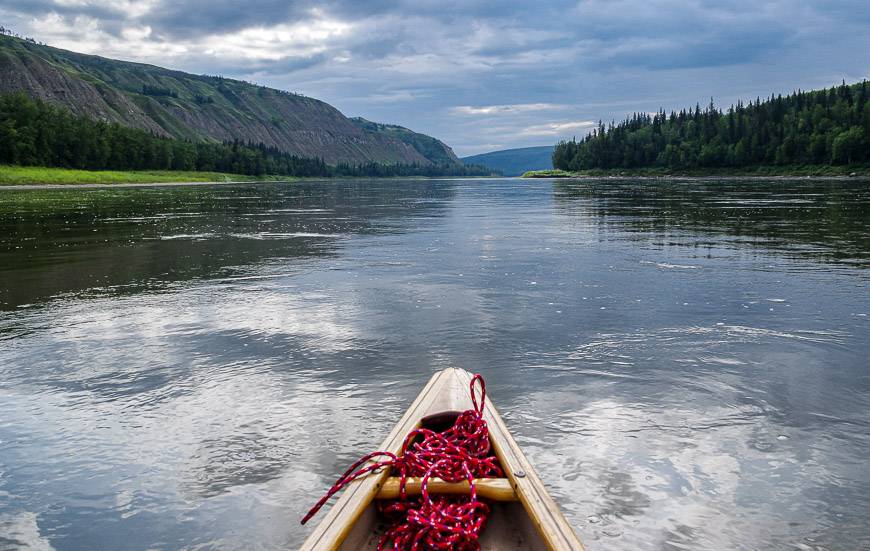
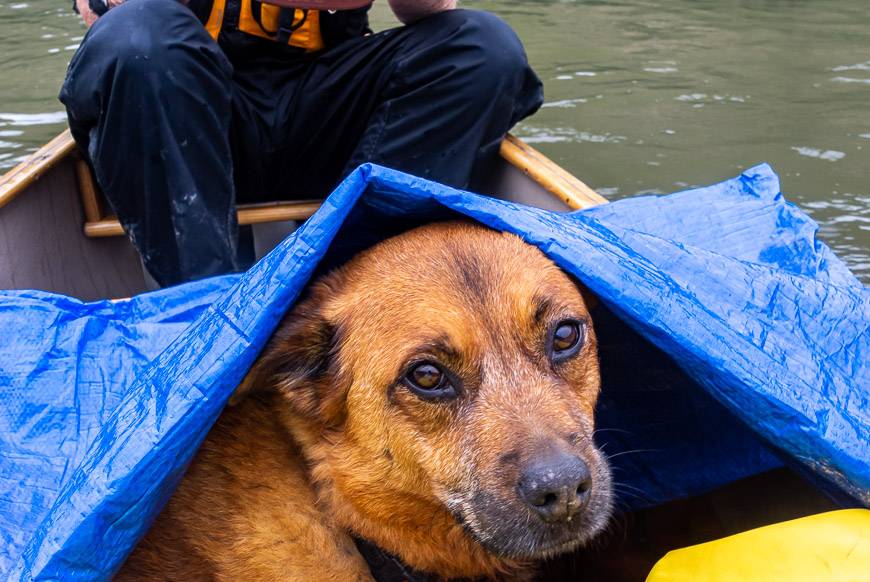
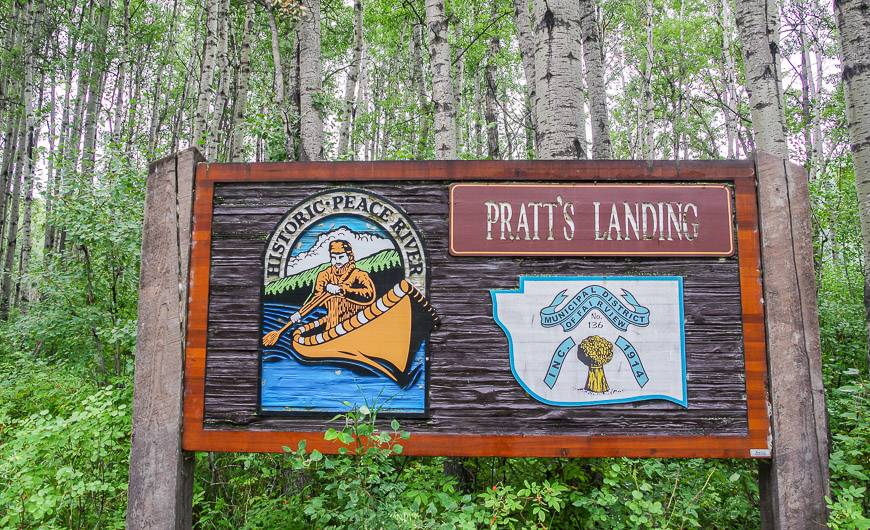
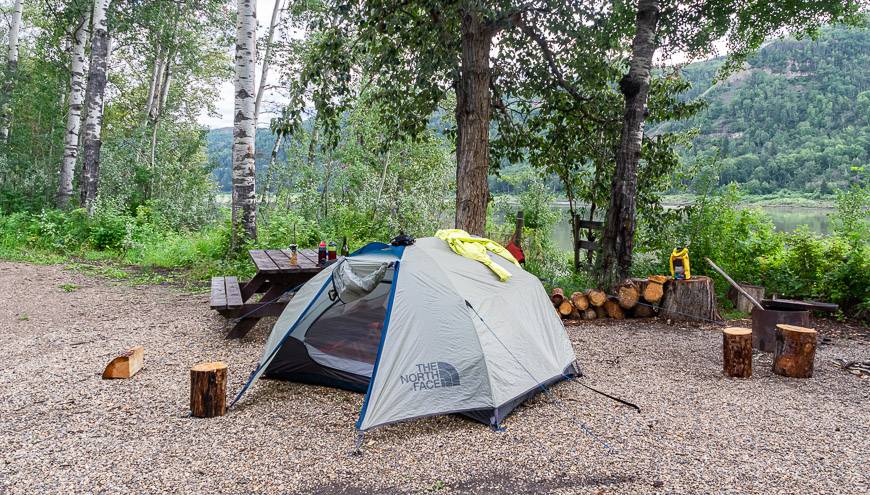
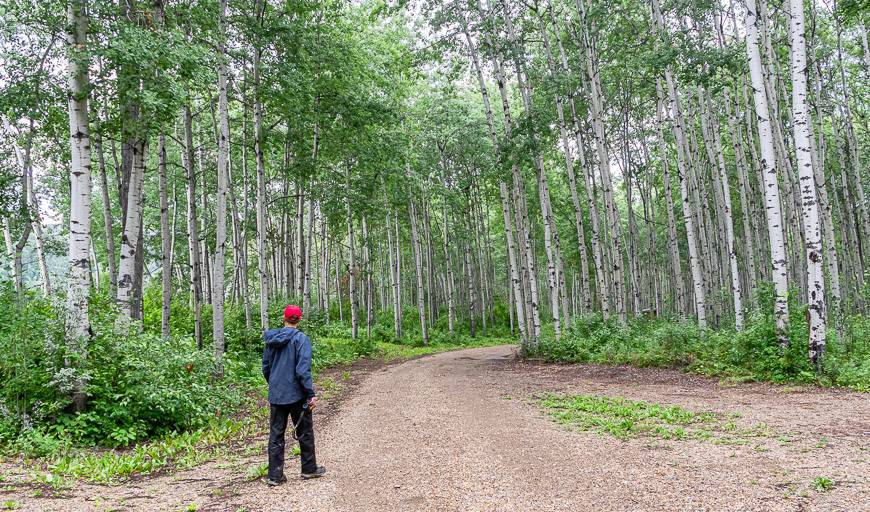
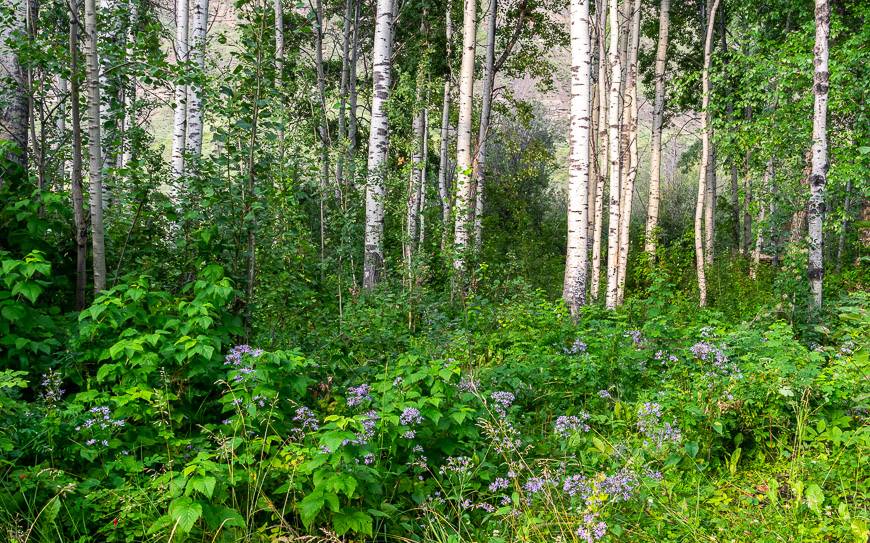
Day 3: Pratt’s Landing to Camp Island
Distance: 70 km
Time: 7 hours paddling plus extra time for breaks
Many people would tackle this paddle over five days instead of four and stay at Dunvegan for the night instead of continuing on to Camp Island.
We opted for a longer day on the river and a shortened tour of historic Dunvegan Provincial Park. But since it had poured hard first thing in the morning we didn’t get going till 9:30. Later we heard that it had teemed with rain for the entire day closer to Peace River. We felt fortunate we only had a few minutes of sprinkles once we hit the water.
It’s a relatively short 28 kilometre paddle to reach Dunvegan. You can pull off on river left past the bridge and then walk up to explore the park. You can camp here for $38 per night in 2025.
Historic Dunvegan and the provincial park share the site. There’s a Visitor Information Centre where you can talk to staff and pick up a map of the area.
You need two to three hours to make the complete tour as there’s a lot to see and a lot of ground to cover. It’s also possible to take a guided tour and if we’d waited around a little longer we could have eaten fresh baked bannock cooked over a fire.
The Peace River has been a corridor of travel for several thousand years. Fire pits and arrowheads from 2000 years ago attest to its use. Europeans and missionaries arrived in the early 1800’s, with the first trading post established in 1805.
Named Dunvegan by Archibald Norman McLeod of the North West Company for “his ancestral castle on the Isle of Skye,” it later merged with Hudson’s Bay Company and operated as a post until 1918.
It’s a short walk from the Visitor Centre to see the beautiful St. Charles Anglican Church and Rectory – but you can’t get inside. We missed the Dunvegan Gardens and were scolded for doing so by Ann of Peace River Cabins. (I guess they’re quite beautiful.)
However, they are a two kilometre return walk from the Visitor Centre and we still had 40 kilometres of paddling to do. And we missed the historic area on the other side of the bridge though we did see some of it from the canoe.
The rest of the paddle, despite its length was a joy. The water was calm and the cloud formations and reflections kept it interesting. Once past Dunvegan there were more signs of life with the occasional cabin or house to be seen high up above the Peace River.
We probably rolled into Camp Island about 7 PM – and again we weren’t quite sure if it was the place to be. It’s used by fisherman – and in the interior, it’s none too pristine so we camped close to the water on high ground.
There are no services here and more mosquitoes than anywhere else. But it was peaceful, at least initially. Later I lay awake wondering what was making munching noises not far from the tent door. I never did find out. That night I finally fell asleep to coyotes howling and owls hooting.
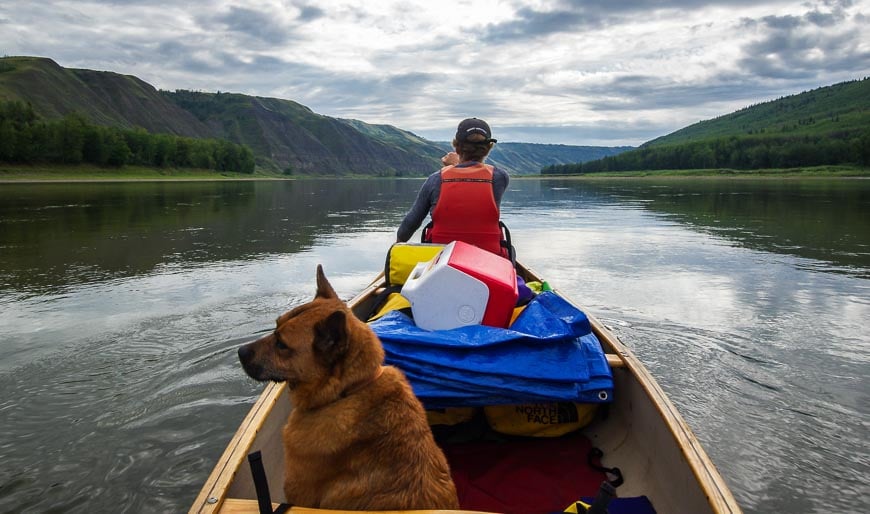
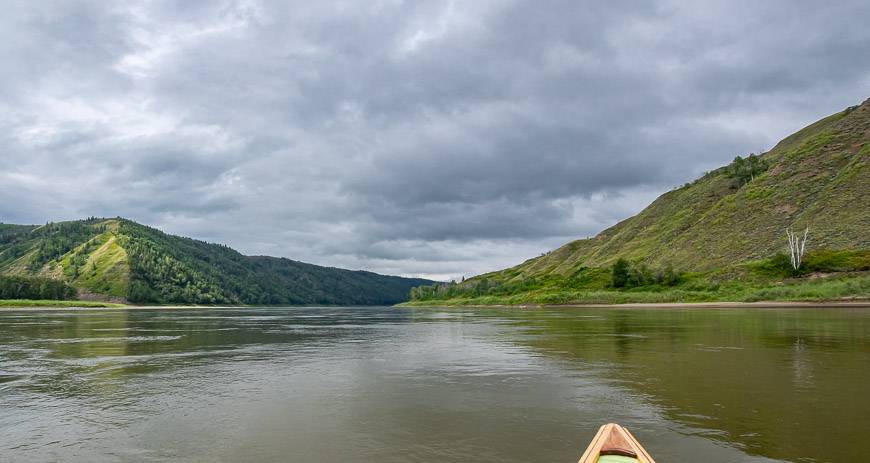
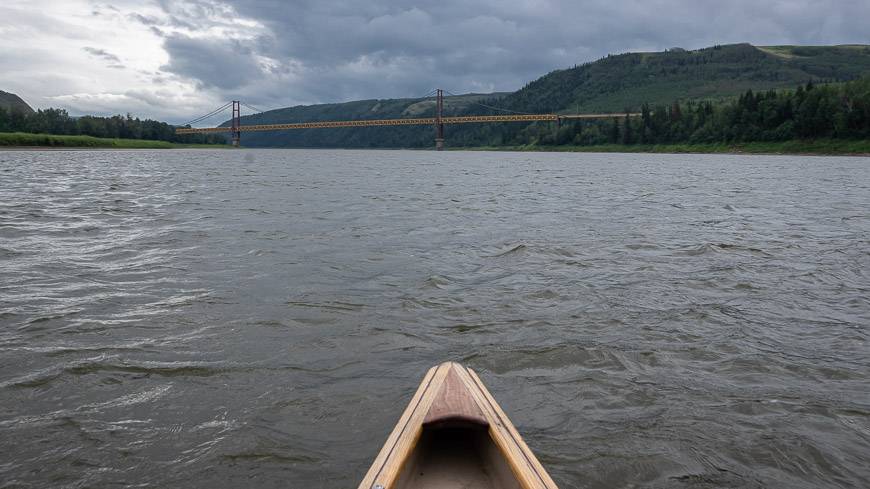
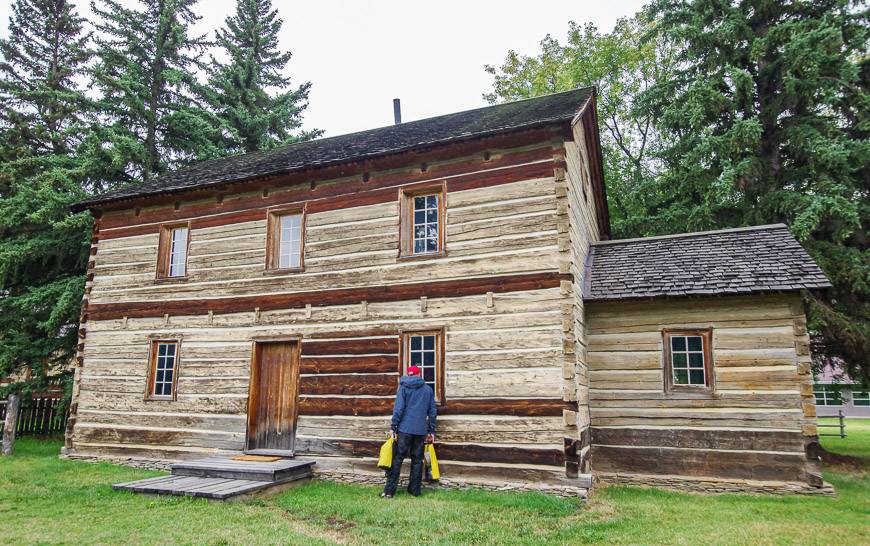
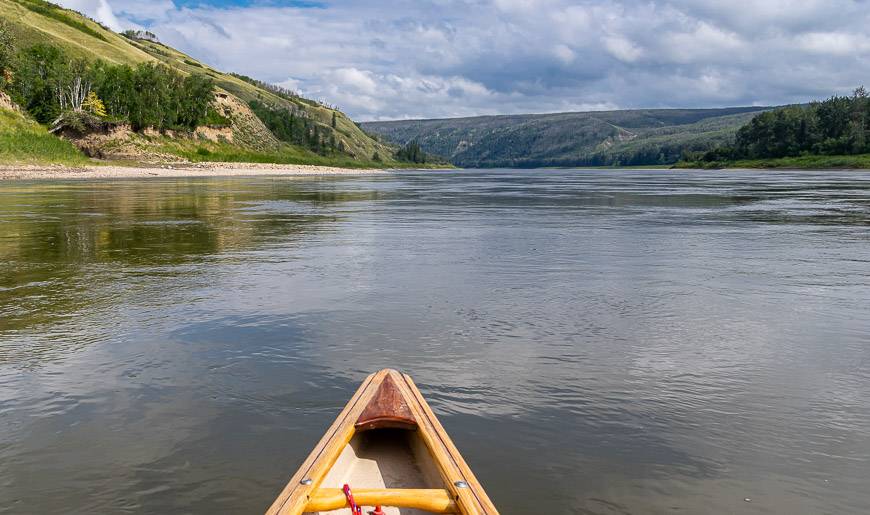
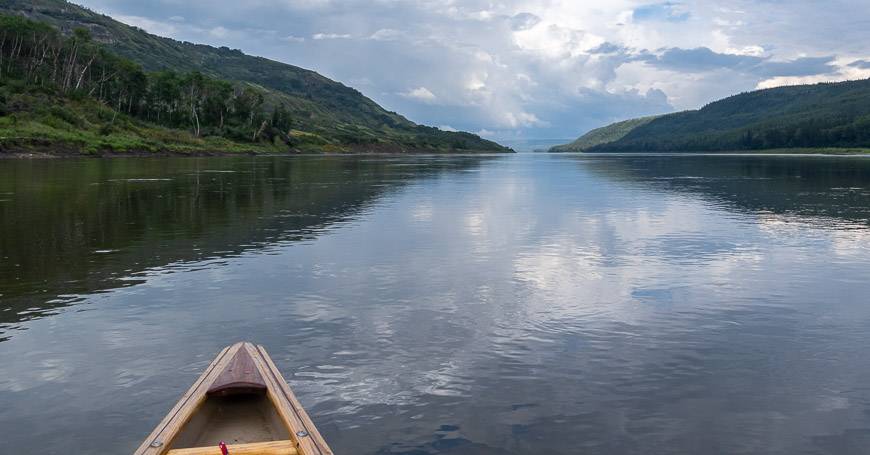
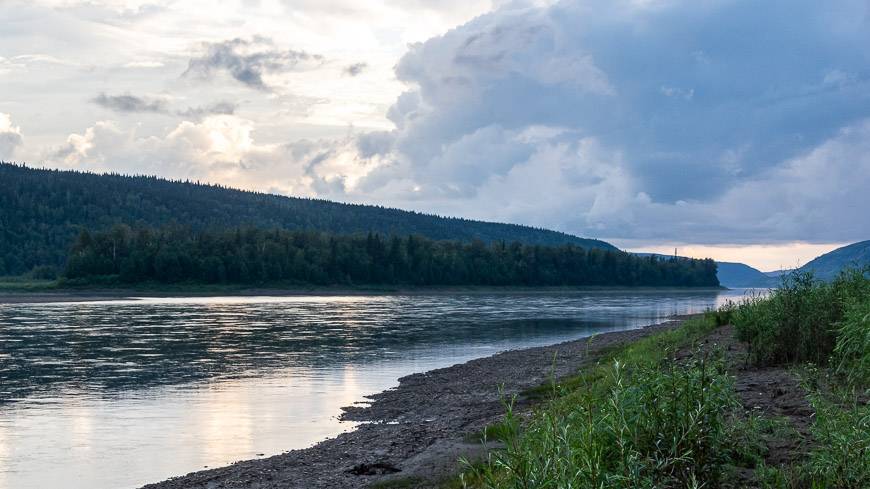
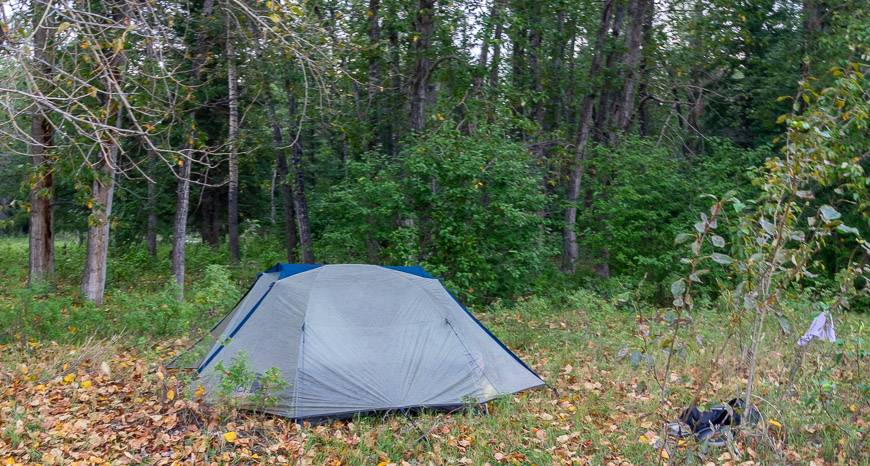
Day 4: Camp Island to Peace River Cabins
Distance: 35 km
Time: 4.5 hours with stops
On the last morning I said to John – I want a moose and a bear today. Less than 10 minutes later I got my bear.
I saw something black jump into the river and start swimming. We coasted as close as we deemed safe (with bear spray very handy) and watched a black bear swim across the river through strong currents in about five minutes. It got up on the far shore, shook once and took off – but all the same it was a real thrill. And I finally got my moose sighting on the drive home.
It was mostly a mellow day canoeing the Peace River on our fourth and final day. Generally the banks were lower than earlier in the trip and the river still retained its deserted feel.
In fact we NEVER saw another paddler and in total over four days we saw only two boats, two fisherman at Camp Island, a handful of people at Many Islands Campsite and some visitors in Dunvegan Provincial Park.
Lunch on the last day was beside a stack of logs left when the river dropped. We saw these on numerous occasions and truly marveled at the power that could carry such a load. At times the Peace River lives up to its other name – the MIGHTY PEACE.
It’s always bittersweet when a trip comes to an end. I’m thankful we made it one piece, and proud of the fact we paddled as far as we did in just four days. Ideally it would have been great to have another day and paddle all the way into the town of Peace River, a further five hours away.
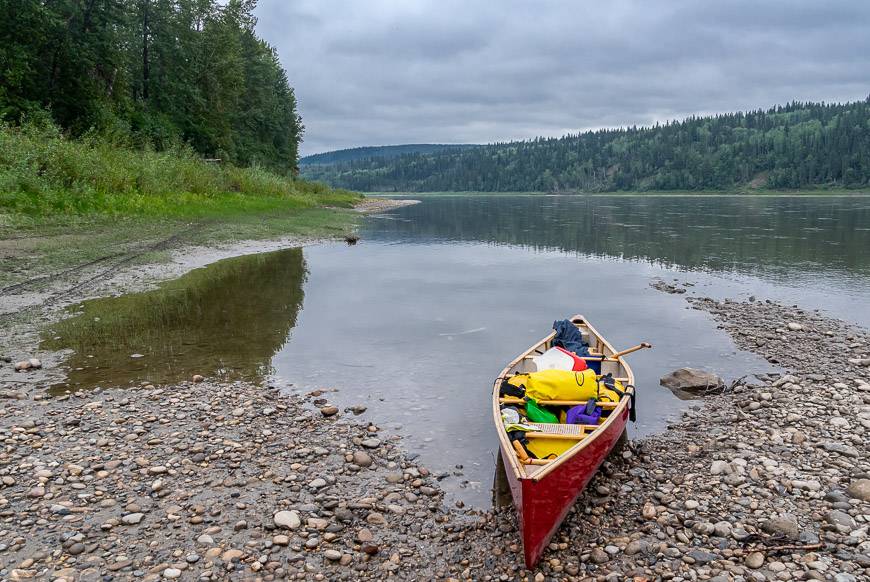
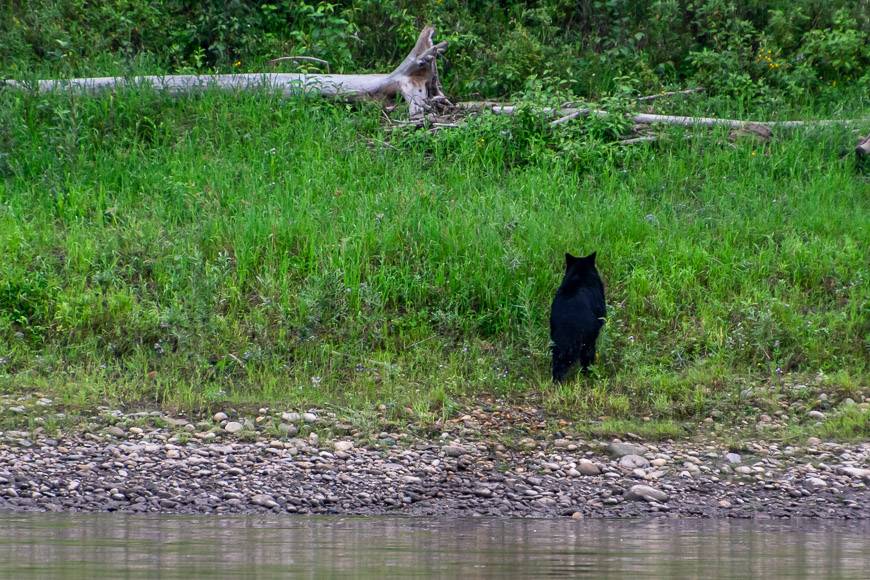
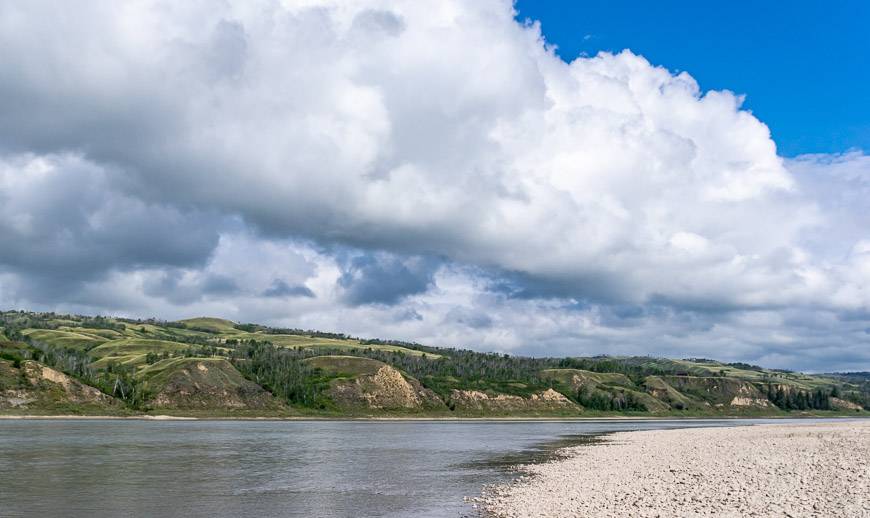
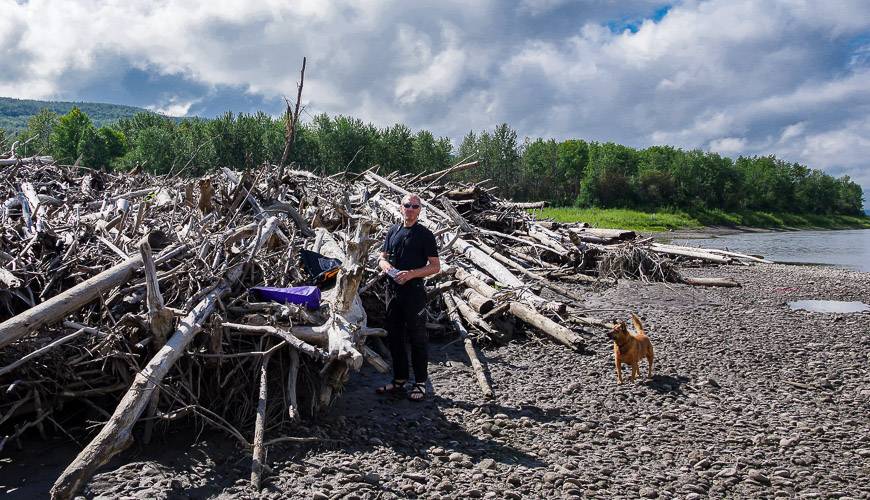
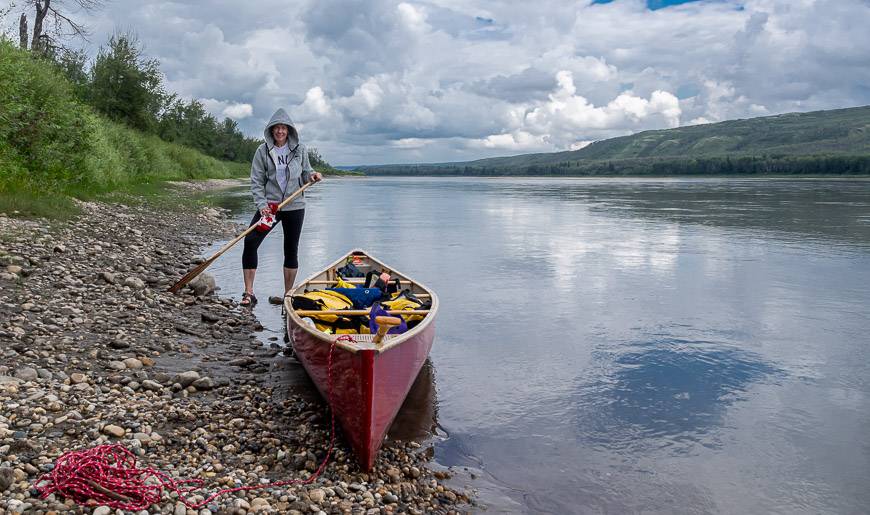
Final thoughts on canoeing the Peace River
According to our hosts at Peace River Cabins the bulk of the people who rent their boats do only day trips to the town of Peace River.
But if you’ve got some paddling skills and you’re comfortable in the wild, I think most every paddler would enjoy this trip.
While canoeing the Peace River is most definitely a wilderness experience – some of Canada’s richest farmland and gas country is just a short distance back from the hills. You’ll only find spotty cell service around Many Islands Campground and Dunvegan Provincial Park.
In theory you can paddle the river from Hudson’s Hope in BC all the way to Horse Point, a total distance of 708 kilometres. Our 175 km canoeing the Peace River was but a small taste of what the mighty Peace has to offer.
A few things that might come in handy for the Peace River canoeing trip
Take water purification tablets as they’re fast and take up almost no room.
A lightweight camping pillow can make a big difference to a good night’s sleep.
Compression sacks for your bulky items are hugely helpful. I always use them for my sleeping bag.
Should any of your gear break, you’ll be happy to have some gear-aid patches with you.
Carry a Garmin InReach Mini in case you run into an emergency.
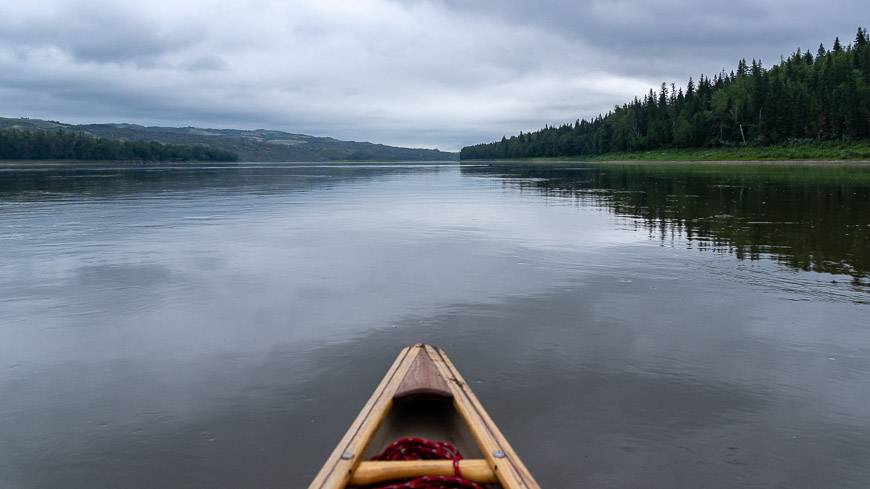
Interested in more paddling trips in Canada?
- Powell Forest Canoe Route – The Full Experience
- A Weekend Canoe Trip on the Red Deer River
- A 3 Day Canoe Trip on the Milk River in Alberta
- The 3 Day Lac la Biche Canoe Circuit in Alberta
- Kayaking Maligne Lake in Jasper National Park
Click on the photo to bookmark to your Pinterest boards.
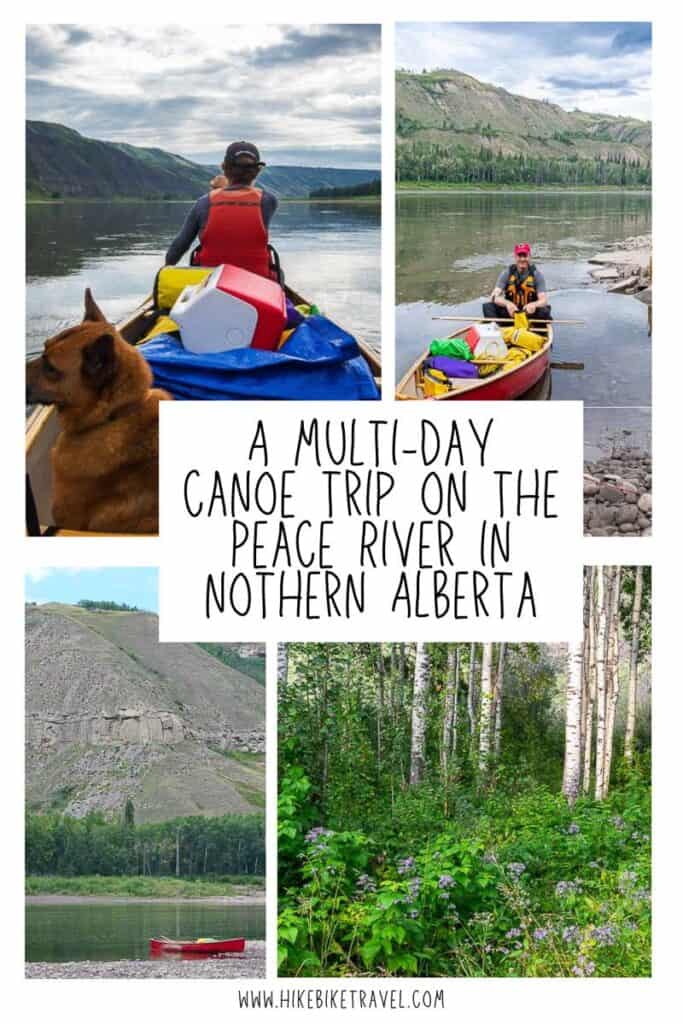
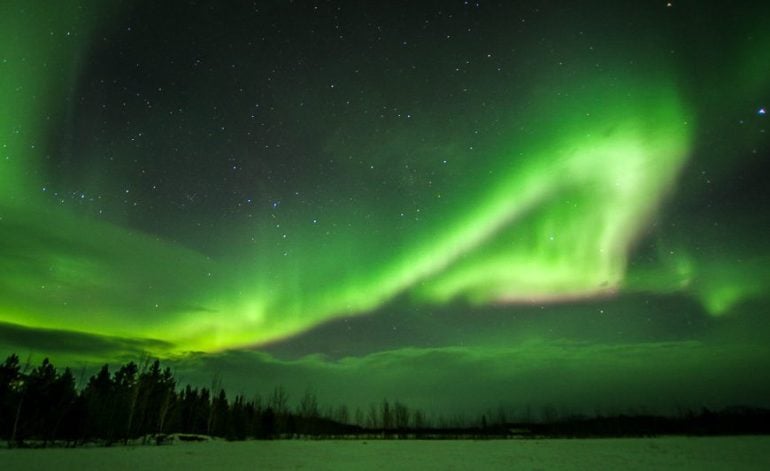
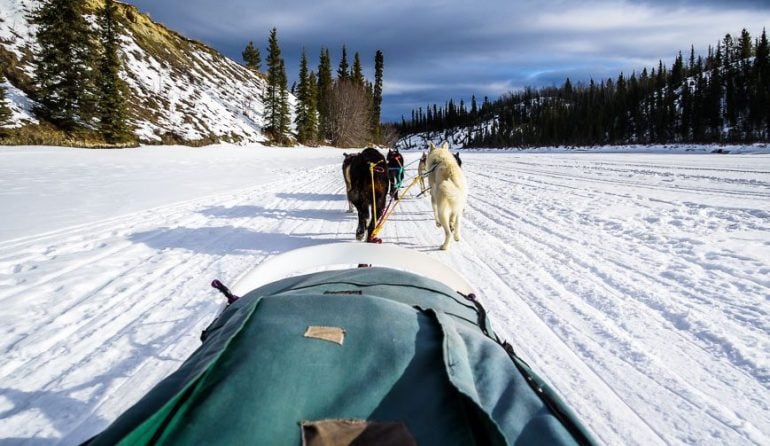
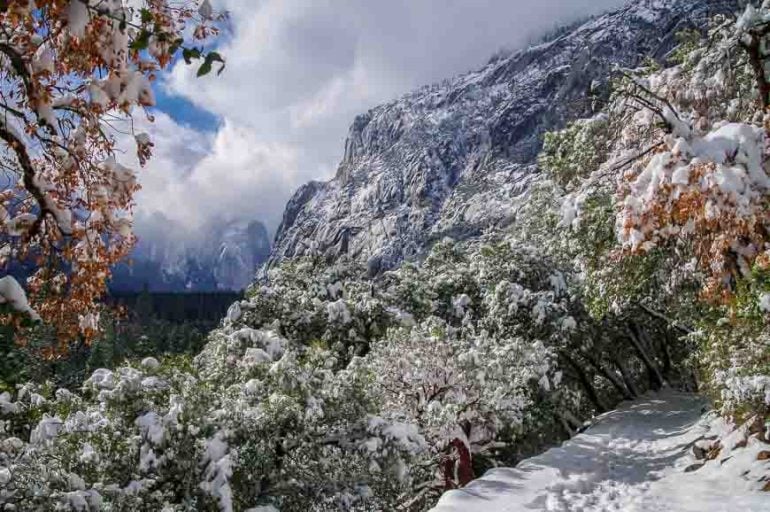
Hi Leigh, thanks for writing about your Mighty Peace canoe trip. I wanted to mention a couple of things you might be interested in.
I’ve done a few canoe trips on the Peace, and some of the best camping is under large evergreen trees on islands. You’re right that this can involve a bit of hiking up a bank, depending on the river level. But for those able to get up the bank, this is the best rough camping. Look for islands with large evergreen trees. Once, I was with a group of 15 and we camped under a huge big tree and managed to stay dry during an epic rainstorm. These rough camping experiences are the most unforgettable parts of the trip. Each time we’ve gone, this has been the highlight.
The other thing I wanted to mention was about Pratt’s Landing. Once upon a time, Pratt’s Landing was a little dirt road leading to an old run down cabin. The local residents of Highland Park (just up the hill) used it for day trips. Then they decided to improve the area and build the beautiful campground you saw. They funded a lot of the work, built it, and still to this day maintain it. The lighthouse is there because jet-boaters, coming back from hunting trips often return after dark. When it’s below freezing in the late fall, this can be very dangerous. There have been some near miss incidents, with hunters missing the boat launch in the dark and spending harrowing nights on the freezing river. So, the local residents decided to build the lighthouse.
The reason it’s quiet is that it’s long past any paved road or tourist trails. Bottom line: nobody except locals knows about it. I’d guess that 95% of campers at Pratt’s are local. You’re lucky to have found this spot, but there’t nothing weird about it being empty. That’s pretty normal. It’s just a legendary local spot that nobody from outside the area knows about 😉
@Zander Thank you for sharing your camping wisdom and your insight into Pratt’s Landing. What a great river the Peace is to paddle and I do hope more people hear about it and try it out – if even for a few days.
I really enjoy hiking and biking, but you may have just sparked the inspiration for me to go out and get that kayak I’ve always wanted. Awesome blog. 🙂
@Vincent Thank you. My best vacations are always on the water.
Apon reading this article….. I would totally agree!! On the third weekend of August I had my opportunity to paddle the Peace!! But only the 27-28 km run from our ferry to the boat launch right in the town of Peace River!! It’s an annual event put on by local municipalities and towns!! Great event!! I’m not a canoe paddler but rather a kayak paddler!! But either way I found a new part to love of the river valley that I have I have known for 40 years ( dating myself) I personally would love to be able to enjoy more time and kilometres on the river!! Thank you for your article on our River and describing it as the beautiful river that it is!!!!!!
@Mike Thanks for reading and leaving a comment. I think it’s a magnificent part of the province that deserves more love. I think kayaking the river would be a great way to explore it.
Thoroughly enjoyed your blog! We will definitely consider this as a family trip for next summer! Thanks for sharing your experience!
@Karlan This would make a great family trip and if you stick to the campsites you’ll have lots of amenities.
Inspirational blog! Our family will be looking into this one for next summer. We paddled the Red Deer river last year through the badlands, another great paddle. Thanks for sharing.
@Mike Thank you for your great comment. The Red Deer is on my wish list for next summer.
What breed is your dog? He looks so like ours.
@Jacqui We call her a Caribbean Cocktail – a mutt (and rescue) from the island of St. Maartens who hates the heat.
What an awesome article. Love the pictures – inspired to do this!
@Kristen And its an easy one to do. Next time I’d bring bear proof barrels.
Your pictures are incredible! I am astonished at the tracks that you found on the one stop and the bear so close!! Looks like your dog had a great trip too. Alberta really is gorgeous and there are so many scenic areas to see. I learned something here about rivers – in that I didn’t actually know they classified them. One day it would be great to visit.
@Paula I have never paddled more than a Class III river and that can be exciting. I’ve rafted a Class IV river and that was nuts.
The Peace River is a great wilderness destination and one I hope more people take the time to see. Thanks for your comment.